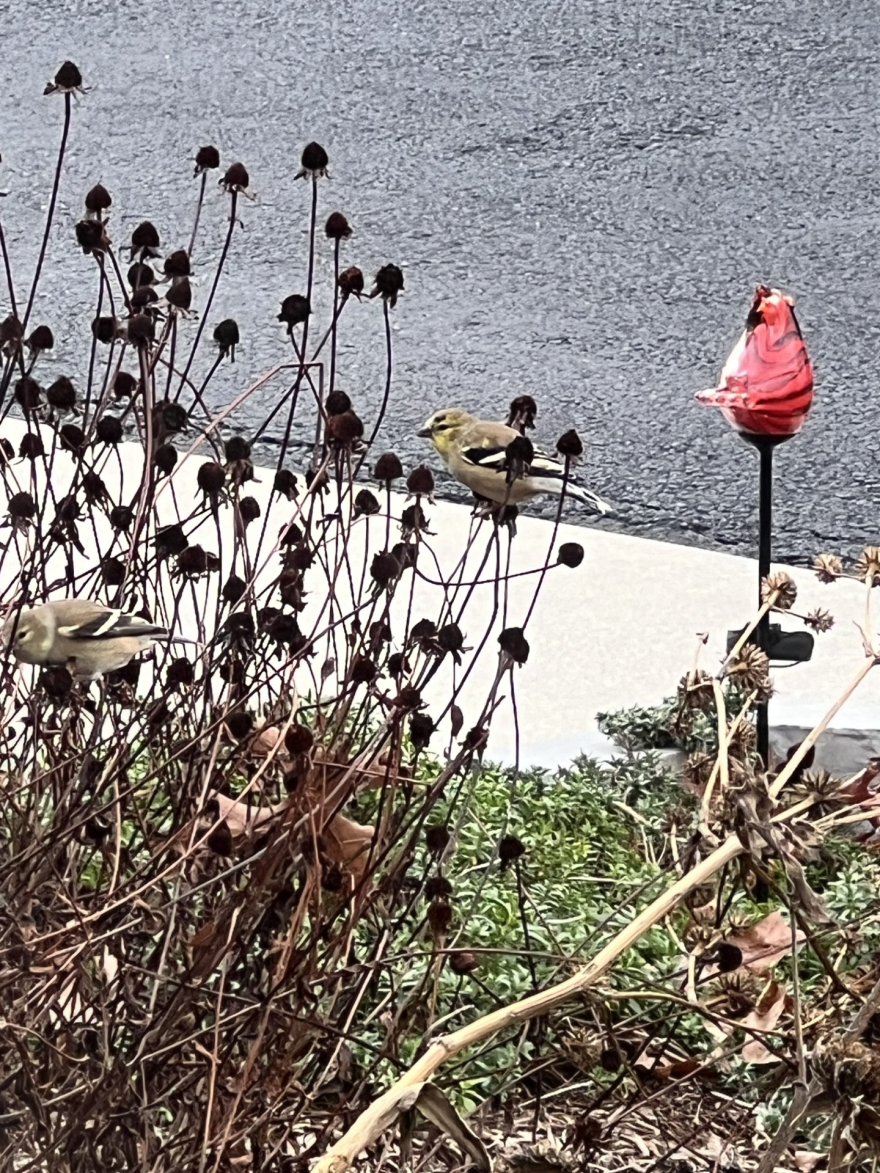This is the time of year when the seed catalogs roll in and I have already started thinking about next year’s garden. One part of my plan is to plant for birds. While we do have many feeders and bird baths around the house, the plants that will support the wild birds are very important too. It is not very likely that a hermit thrush or yellow-rumped warbler will come to any of the feeders, no matter what type of seed or suet I provide. In one of the back corners, we have let pokeweed (Phytolacca americana) and blackhaw viburnum (Viburnum prunifolium) grow wild, and the fruit of both these plants feed a variety of bird species in the fall.
In a more manicured space, another favorite for me, pollinators and birds is annual sunflowers (Helianthus annuus). There is a sunflower for every garden since they come in petite sizes at 1–2 feet tall, and every height in between to the mammoth gray stripe at 12 feet tall! Sunflowers range in color from the lightest yellow to burgundy and leaving the seed heads out in the garden will delight birds like chickadees, titmice, finches and potentially bring woodpeckers too.
Make sure your sunflower variety has pollen for the insects, as there are pollenless varieties out there. I’ve learned to buy seeds every year I get some sunflower plants, and I am not sure a single seed is left to grow since I have chipmunks in the garden too. I am also adding perennial, native sunflowers like the woodland sunflower (Helianthus divaricatus) to my gardens to see if that is also attractive to birds.
Some other perennials that birds really enjoy are Rudbeckias (brown and black-eyed Susans), Echinaceas (coneflowers) and Pycnanthemum (mountain mints: hoary, narrow-leaf, etc.). All of these are easy to grow and since we have more and more native plants for sale, easier to find! One of my mountain mints is a cluster more than 5 feet across that came from a very small starter plant from a neighbor just a few years ago. Now we see the field sparrows and American goldfinches on the mountain mints. I have several native Rudbeckia plants outside my study, and they bring the goldfinches very close for me to watch through the window.
If you have room for trees, there are some great choices to support the local birds. Two small trees that are wonderful are the flowering dogwood (Cornus florida) and Eastern redbud (Cercis canadensis). In fall, red dogwood berries are very attractive to birds, including northern mockingbirds and American robins. The redbud flowers are a tasty, early food for both cedar waxwings and northern cardinals.
Larger trees to add include any of the serviceberries (Amelanchier sp.). The serviceberries range from multi-stem large shrubs to very large trees. They will not disappoint! Serviceberries have lovely white flowers in spring, berries in summer, then gorgeous fall color. Gray catbirds, mockingbirds, robins and waxwings will all sit in the serviceberry waiting for the fruit to ripen — it’s a real bird magnet! A tree that was surprising for its interest to birds was the native persimmon (Diospyros virginiana). I watched the pileated woodpeckers go after and eat the persimmon fruits still hanging on the tree. It is spectacular to watch a crow-sized woodpecker swinging on the end of the branch while trying to shake the fruit loose.
As you are thinking of gardening for birds, make sure to leave the seed heads on the stems after the blooms are done. I have changed course as a gardener, leaving plant material like stems, stalks and dried flower heads with seeds right where it grew. By leaving the vegetation, the native insects have a winter home and the local birds get meals. I save so much time in fall, no cleanup required.

In spring, once the plants begin to green up and leaf out, I might snap old, dried stalks and throw them down in place as mulch. What I have found in spring is that most of the old vegetation took care of itself by composting in place.
Happy Gardening!
Robyn











